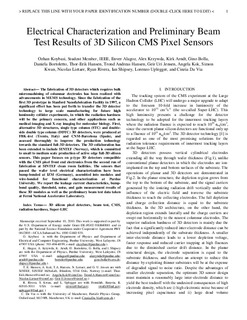Electrical Characterization and Preliminary Beam Test Results of 3D Silicon CMS Pixel Detectors
| dc.contributor.author | Koybasi, Ozhan | |
| dc.contributor.author | Alagoz, Enver | |
| dc.contributor.author | Krzywda, Alex | |
| dc.contributor.author | Arndt, Kirk | |
| dc.contributor.author | Bolla, Gina | |
| dc.contributor.author | Bortoletto, Daniela | |
| dc.contributor.author | Hansen, Thor-Erik | |
| dc.contributor.author | Hansen, Trond Andreas | |
| dc.contributor.author | Jensen, Geir Uri | |
| dc.contributor.author | Kok, Angela Chun Ying | |
| dc.contributor.author | Kwan, Simon | |
| dc.contributor.author | Lietaer, Nicolas | |
| dc.contributor.author | Rivera, Ryan | |
| dc.contributor.author | Shipsey, Ian | |
| dc.contributor.author | Uplegger, Lorenzo | |
| dc.contributor.author | Da Via, Cinzia | |
| dc.date.accessioned | 2017-02-09T15:01:28Z | |
| dc.date.available | 2017-02-09T15:01:28Z | |
| dc.date.created | 2012-01-02T16:15:45Z | |
| dc.date.issued | 2011 | |
| dc.identifier.citation | IEEE Transactions on Nuclear Science. 2011, 58 (3), 1315-1323. | nb_NO |
| dc.identifier.issn | 0018-9499 | |
| dc.identifier.uri | http://hdl.handle.net/11250/2430213 | |
| dc.description.abstract | The fabrication of 3D detectors which requires bulk micromachining of columnar electrodes has been realized with advancements in MEMS technology. Since the fabrication of the first 3D prototype in Stanford Nanofabrication Facility in 1997, a significant effort has been put forth to transfer the 3D detector technology to large scale manufacturing for future high luminosity collider experiments, in which the radiation hardness will be the primary concern, and other applications such as medical imaging and X-ray imaging for molecular biology. First, alternative 3D structures, single type column (STC) and double-side double type column (DDTC) 3D detectors, were produced at FBK-irst (Trento, Italy) and CNM-Barcelona (Spain), and assessed thoroughly to improve the production technology towards the standard full-3D detectors. The 3D collaboration has been extended to include SINTEF (Norway), which is committed to small to medium scale production of active edge full-3D silicon sensors. This paper focuses on p-type 3D detectors compatible with the CMS pixel front end electronics from the second run of fabrication at SINTEF clean room facilities. The sensors that passed the wafer level electrical characterization have been bump-bonded at IZM (Germany), assembled into modules and wire-bonded for functional characterization at Purdue University. We report the leakage current characteristics, bump-bond quality, threshold, noise, and gain measurement results of these 3D modules as well as the preliminary beam test data taken at Fermi National Accelerator Laboratory. | |
| dc.language.iso | eng | nb_NO |
| dc.title | Electrical Characterization and Preliminary Beam Test Results of 3D Silicon CMS Pixel Detectors | nb_NO |
| dc.type | Journal article | nb_NO |
| dc.type | Peer reviewed | nb_NO |
| dc.source.pagenumber | 1315-1323 | nb_NO |
| dc.source.volume | 58 | nb_NO |
| dc.source.journal | IEEE Transactions on Nuclear Science | nb_NO |
| dc.source.issue | 3 | nb_NO |
| dc.identifier.doi | 10.1109/TNS.2011.2117439 | |
| dc.identifier.cristin | 874978 | |
| cristin.unitcode | 7401,90,31,0 | |
| cristin.unitname | Mikrosystemer og nanoteknologi | |
| cristin.ispublished | true | |
| cristin.fulltext | postprint | |
| cristin.qualitycode | 1 |
Tilhørende fil(er)
Denne innførselen finnes i følgende samling(er)
-
Publikasjoner fra CRIStin - SINTEF AS [5802]
-
SINTEF Digital [2501]
